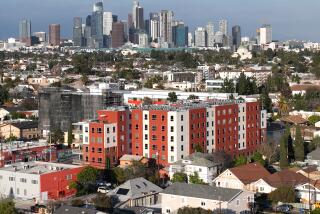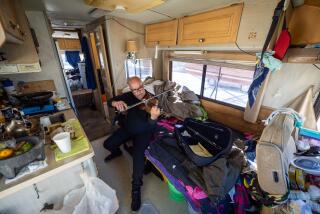Bahama Descendants Fear Gentrification Will Force Them From Village
KEY WEST, Fla. â Jerline Edwards isnât budging, no matter how much the young professionals and developers in this resort town offer for her crumbling clapboard houses that have been in her family for five generations.
âNo, weâre not selling. The money would go to the devil and you have no place to stay,â says the 69-year-old Edwards. âTheyâre going to force us out anyhow. As sure as the devil, Iâm telling you. We all lived as one when we were coming up--the Cubans, the conchs and the Nassaus. Uh uh, nope, no more.â
Most of the Cubans have gone north and the âconchs,â or native Key Westers, are comfortably on the other side of the main tourist track of Duval Street.
But about 2,000 of the islandâs blacks whose families came from Nassau and other parts of the Bahamas are caught in a struggle to pull themselves out of poverty while retaining their heritage and ownership of a community that dates back to the 1820s.
Bahama Village is a 12-block area of hidden beauty and destitution, a stoneâs throw away from the cityâs slick, overbuilt tourism district.
Everyone here is family in one way or another, welcome on any of the rickety porches of the old wooden houses and cottages that have been handed down and built back up for more than a century.
Streets that were only recently paved are named after the first Bahamians who migrated to the nationâs southernmost island, blacks who were freed from British slavery long before blacks in America were granted theirs and fishermen who sailed toward more plentiful sponge and turtle catches.
âBahama Village is the only part of Key West thatâs left that reminds me of the Key West I knew when I was growing up,â says City Commissioner Jimmy Weekley, a lifelong resident of the island and critic of its increasing development.
âItâs still a neighborhood where they really know each other,â Weekley says. âThe rest of the city has lost that flavor.â
But the area is also the cityâs crack cocaine center. Most of the residents in the square-mile community are living under the poverty level and frequent allegations of police brutality and neglect by city officials have polarized the haves and have-nots of Key West.
There are few jobs for young blacks in the area, and escalating property taxes are making it harder for the longtime residents to stay and live comfortably.
âMost of the people will tell you that their grandparents and great-grandparents slaved to build what they have here today,â says the Rev. Samuel E. Leach, pastor of the A.M.E. Zion Church in the village. âTheyâre not going anywhere. They intend to be buried here. Now the younger people, thereâs nothing for them here in Key West.â
Mayor Tony Tarracino--known on the island as (Captain Tony) --walks through Bahama Village and everyone knows him by name. He shakes hands and promises a young entrepreneur working on a Caribbean restaurant he hopes to open soon that the city will help. He attends a Sunday service at Leachâs church and stuffs money into the offering envelope.
âThey are beautiful people,â Tarracino says to a reporter. âI feel guilty, sometimes, you know?
âBut weâre throwing a lot of money in here. And the whites are starting to come in.â
Therein lies the problem, say many of the villagers. The whites are starting to come in. They are buying up and renovating the old houses with outside labor and outside dollars. That, in turn, is jacking up taxes and rents, already quite high on the island.
âThis cute little quaintness means big bucks,â says Merlin Curry, 43, a third-generation Bahamian who grew up in the neighborhood. âGentrification is happening so quickly that itâs hard to get a grip on it.â
Curry talks about the village over the hammering and laughter of friends who have come by to help prepare for the opening of Blue Heaven, his Caribbean restaurant. The old 19th-Century house was once a bordello and saloon, another Key West haunt said to have been frequented by Ernest Hemingway and cock fighters.
Curry is wary about the future of his village.
âEventually it will turn into another Duval Street, itâs sad to say,â Curry says.
The average person in the village, Curry says, makes $5 or $6 an hour, yet their rents are $500 to $600 a month and can run as high as $900 in the housing project.
Floyd Sweeting, owner of Floydâs Barber Shop in the village, welcomes restoration and grant money, although he knows he is bound to be hit hard.
âMy property would go up and I can barely afford to pay what Iâm paying,â he says. âIt escalates every year.â
Sweetingâs taxes, which include levies on a barber shop and two rental units, have gone from $1,316 in 1982 to $2,264 in 1990.
On a recent Sunday morning, James Chapman, a 52-year-old, fourth-generation Bahamian with 15 children, was playing dominoes in a gutted building that has become a makeshift community center.
âI was born in that house across the street,â says Chapman, pointing out the front door. âMost people feel like I feel. We just canât afford it. A lot of people just sold their homes and left.â
Many of the villageâs original settlers have moved to central Florida where the cost of living is more reasonable.
âWho can afford a $20 T-shirt? Many of us here, weâre on welfare,â says Chapman, whose great-grandfather has a street in the village named for him.
At the same time, Chapman and other neighbors have kind words for Steve Justi, a 34-year-old white real estate broker who moved to the village from Miami 12 years ago and has renovated a half-block of houses, where he also lives.
âYouâre evaluated more as an individual here,â Justi says. âI mean, here my neighbor bakes me pies.â
Yet Justi concedes that he often struggles with the ethics of gentrification.
âItâs a sensitive issue. Itâs going to happen and I donât think you can ignore it,â says Justi, sitting next to a birdhouse he has built among the five old Bahama houses he has renovated. A white picket fence lines the property around the whitewashed homes.
âMy fear is that people are going to come in and destroy the charm and make it too slick. I may be partly to blame for that.â
Norman Moodie Jr. is another young entrepreneur who came from the outside and took a chance on the village.
He opened the Caribbean House, cater-cornered from the Blue Moon and just up the street from the ma-and-pa grocery stores where storefront beer drinking is constant.
The Caribbean House--where tropical-style rooms with tile floors and ceiling fans run from $45 to $95 nightly--has become a model for other development in the neighborhood.
Moodie, a 34-year-old black man who discovered the area while in the Coast Guard off Key West, insists that gentrification can be healthy.
âI see an opportunity to help these people while Iâm here,â Moodie says. âThis is a $300,000 investment in the middle of a community that said I was crazy and it wouldnât work. Well, itâs working and the street is going to come back to life. Iâm trying to show the community how to participate in the riches of tourism and not just be bystanders who see the money go elsewhere.â
The City Commission recently allocated $75,000 to hire a consultant who would study the village to determine if it qualifies for federal grants for commercial development.
Roy Grant, the founder of the Key West Neighborhood Improvement Assn. in 1978, has been working for years on sprucing up Bahama Village. He says itâs only now becoming a reality.
âI feel that this is a dream coming true,â says Grant. He has no time for those who complain about progress pushing out the settlers.
âWe have to look at the big picture. We canât continue to sleep. Youâve got to wake up and get into the mainstream. And in order to do that, thereâs got to be some sacrifices.â
More to Read
Sign up for The Wild
Weâll help you find the best places to hike, bike and run, as well as the perfect silent spots for meditation and yoga.
You may occasionally receive promotional content from the Los Angeles Times.






